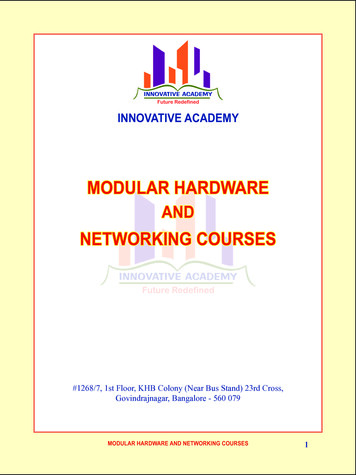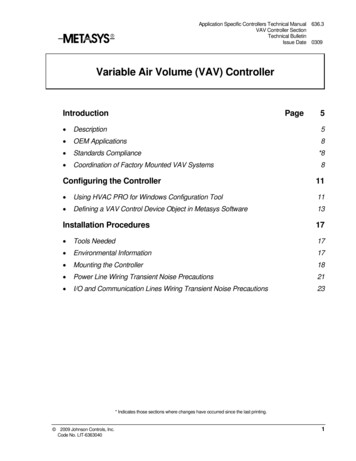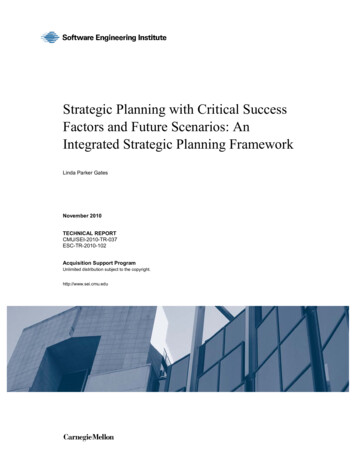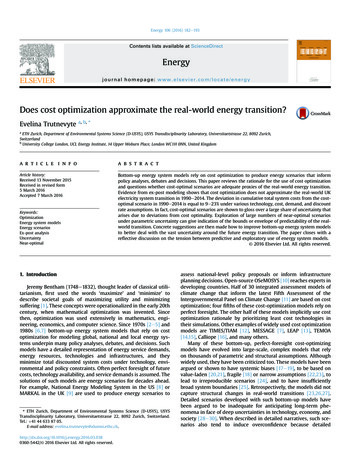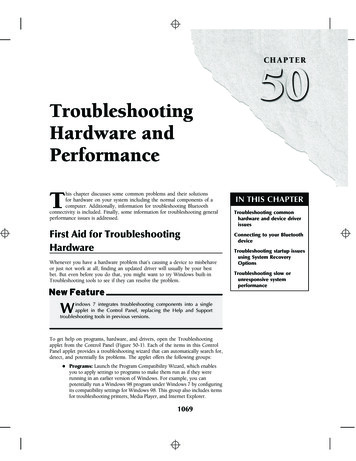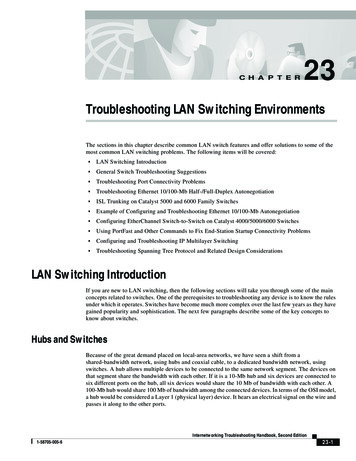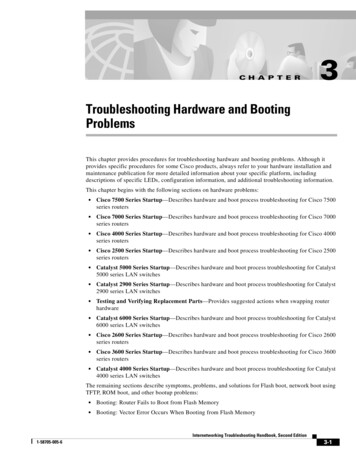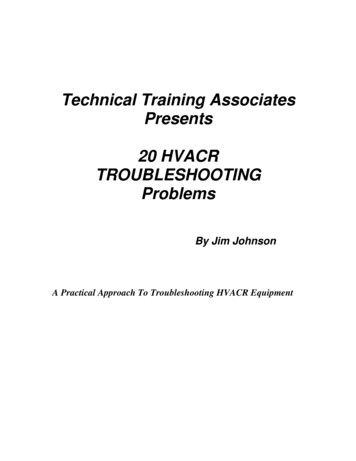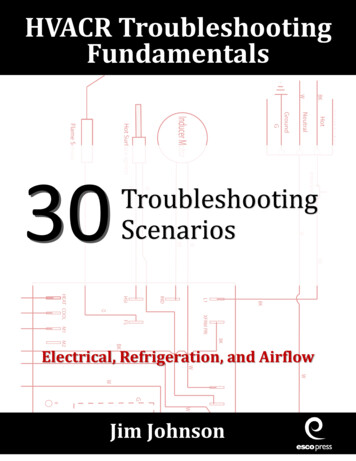
Transcription
HVACR iosElectrical, Refrigeration, and AirflowJim Johnson
HVACR Troubleshooting FundamentalsElectrical, Refrigeration & Air Flow30 Troubleshooting ScenariosLibrary of Congress Cataloging-in-publication DataJohnson, JimHVACR Troubleshooting Fundamentals: Electrical, Refrigeration & Air Flow: 30 TroubleshootingScenariosISBN-13: 978-1-937659-21-9 2019 The MIE InstututePO Box 2259Green Valley, AZ 85622-2259ALL RIGHTS RESERVED. No part of this work covered by the copyright herein may bereproduced, transmitted, stored or used in any form or by any means graphic, electronic,mechanical, including but not limited to photocopying, recording scanning digitizing, taping, Webdistribution, information networks, or information storage and retrieval systems, except aspermitted under Section 107 and 108 of the 1976 Copyright Act, without the prior writtenpermission of the publisher.
Notice To The ReaderThe author and publisher do not warrant or guarantee any of the products described herein. Theauthor and publisher do not assume, and expressly disclaims, any obligation to obtain andinclude any information other than that provided by the manufacturer.The reader is expressly warned to consider and adopt all safety precautions that might beindicated by the activities indicated herein and to avoid all potential hazards. By following theinstructions described herein, the reader willingly assumes all risks in connection with suchinstructions.The author and publisher make no representations or warranties of any kind, including but notlimited to, the warranties of fitness for particular purpose or merchantability, nor are any suchrepresentations implied with respect to the material set forth herein, and the author andpublisher take no responsibility with respect to such material.About This E-Book:The 30 troubleshooting situations presented in this e-book are from the appendices of thefollowing two titles published by ESCO Press:HVACR Troubleshooting Fundamentals: Electricity & Wiring DiagramsHVACR Troubleshooting Fundamentals: Refrigeration & Air Flow Systems
Preface FromHVACR Troubleshooting Fundamentals:Electricity & Wiring DiagramsThe philosophy of this book is that a firm understanding of the fundamentals of electricity andthe ability translate the ‘language’ of wiring diagrams that employ symbols, are the foundation todeveloping the skills necessary to accomplish a proper diagnosis when troubleshooting electricalfailures in HVACR equipment.The HVACR service industry doesn’t need parts changers. What the craft needs are technicalprofessionals who are confident in their ability to use wiring diagrams and test instruments toisolate the source of an electrical problem, then replace what needs to be replaced .and onlywhat needs to be replaced .in order to get a customer’s equipment back on line in a timelymanner and at a fair price.Interpreting and understanding wiring diagrams is a process of learning a second language.Someone who is fluent in both English and Spanish can immediately recognize that the term“perro” in Spanish translates directly to “dog” in English. And they also understand that thetranslation can be more specific, such as “la perra” translating to “female dog”. The reason abilingual person can make this distinction is that they pursued the study of language beyond thevery basic elements of the process, investing the time and effort necessary to understand it at ahigher level. In the case of the above example, it involves learning about the refined methods ofpresenting the differences between masculine and feminine in language.And so it goes with wiring diagrams. A schematic symbol such as this . .could be referred to simply as a switch because that is fundamentally what it is.
However, a more specific definition of this symbol would be a close-on-temperature-rise switch,a thermostat; a thermostat that, when closed due to its sensing a rise in temperature, initiates thecooling cycle of HVACR equipment.A competent and confident HVACR electrical troubleshooter has a complete understanding ofwiring diagrams. And they are dedicated to putting that knowledge to use in an ever-changingcraft in which the learning continues throughout their career.
Preface From HVACR TroubleshootingFundamentals: Refrigeration & Air Flow SystemsFor technicians, it’s always about troubleshooting.Most of the time, it’s a very direct situation. A customer calls and says, “My air conditioner isrunning but the house is warm” or, “Our walk-in is running at 55 degrees” or, the informationyou get may be in simple, two-word sentences: “No heat”, “No ice”, “Not running”.In some cases, you may be called on to perform preventive maintenance, but that’s stilltroubleshooting. You’re evaluating the performance of the equipment, checking components todetermine whether or not they may be potential problem, and comparing the actual results you’regetting from your tests to what you know to be the normal operating characteristics ormanufacturer’s specifications of the equipment.Or, you may be tasked with accomplishing an equipment installation, which is also a form oftroubleshooting. If the installation isn’t done right, then the system can’t perform as it isdesigned to, and a problem will have to be solved before that equipment will be able to transferheat properly, move air properly, or make the correct size of ice cubes.The philosophy behind this book is to consider troubleshooting from a simple and directapproach, beginning with understanding a to-the-point definition of the process:Troubleshooting is the systematic elimination of possibilities.And, along with this simple definition, there is a question you need to consider when you arelearning to troubleshoot:How will you ever know what’s wrong with something if you don’t know what right is in thefirst place?In some cases, knowing what right is comes down to simple common sense; a generalunderstanding of the components of a refrigeration system, along with the process of indoor airflow through a duct system along with the outdoor air flow through a coil, and how thesesystems fundamentally work in all applications.And sometimes, the only source for right is the manufacturer’s specific fault code andexplanations, along with step-by-step troubleshooting procedures.
Whether the information must simply be understood from an overall perspective, or gleanedfrom a manufacturer’s instructions, tracking down the source of a problem in a refrigeration, orair flow system is a skill that must be developed on an individual basis.Different people think differently, and what may seem to be the wrong place to begintroubleshooting a given problem for one person, may be the right place for another. With basicconcepts of HVACR equipment operation understood, in order to benefit most from the contentsof this text, an effort on the part of the reader is necessary.While there may be some things that can be learned in a passive mode, troubleshooting isnot one of them.In order to become an effective refrigeration and air flow systems troubleshooter, a firmunderstanding of the basics of refrigeration and air flow concepts must be established beforeequipment performance problems can be diagnosed, or air flow systems can be evaluated. Withthe information in this book fully understood, you will have the foundational tool you need to putyour knowledge into practice. And practice actually doing the work .is what you need to doin order to achieve a level of mastery in your craft.Gaining knowledge is a fundamental step to being a technician, but only experience can make youan expert in your field.This is not to say that every time you connect a set of gauges to a system you have to stop andreview the fundamentals of heat transfer and thermodynamics before you check refrigerantpressures. Or that you need to go through every fundamental concept related to the science ofpsychrometrics before using an anemometer or flow hood to measure air flow in a comfortcooling or heating system.However, knowing the fundamental concepts of what makes things work, and eliminating themystery behind it all, clears the way for a full understanding of how refrigeration and indoor andoutdoor air flow systems are used to perform work in HVACR equipment.And once you know and you know you know you can become a true troubleshooter.
ContentsSection One: 15 Electrical Troubleshooting ProblemsA Heat Pump That’s Not Keeping The Building Comfortable .A Comfort Cooling System That’s Nor Performing Like It Should A No Heat Complaint .An Electric Furnace That’s Not Keeping The HouseWarm Enough .A Two Stage Air Conditioner That’s Not Working .A Small Commercial Unitary System That’s Not Heating A Split System That’s Blowing Fuses .A Condensing Gas Furnace That’s Not Heating .A Package Unit That’s Not Cooling .The Excessively Expensive Heat Pump .An Electric Furnace That’s Not Heating Enough .A System That’s Blowing Warm Air .A No Cooling Complaint .An Ice Machine That Isn’t Dispensing Cubes Properly .A Comfort Cooling System That’s Not Keeping Up With The Load .
Section Two: 15 Refrigeration & Air Flow TroubleshootingProblems#1: Normal Refrigeration Pressures, A Sweating and Frosted SuctionLine, and Excessive Current Draw .#2: Lower Than Normal System Pressures and A CompressorCurrent Draw That Is Far Below Normal .#3: Lower Than Normal Refrigerant Pressures and A HigherThan Normal Current Draw #4: System Pressures Lower Than They Should Be and ALow Current Draw .#5: High Side Lower Than Normal and Low Side In A Vacuum .#6: Vacuum On The Low Pressure Side, High Side HigherThan Normal #7: Low Side Pressure In A Vacuum, High Side Pressure SlightlyHigher Than It Should Be, Current Draw Lower Than Normal .#8: Differential Between Low and High Pressure Side of The SystemAre Closer Together Than They Should Be .#9: High Side Pressure Higher Than It Should Be, Current Draw Of TheCompressor Excessive .#10: Equipment With A History, Customer’s Complaint That TheHouse Is Always Sticky .#11: A Follow Up On A Heat Pump Reversing ValveReplacement .#12: A Customer’s Complaint That The House Just Isn’t AsComfortable As It Should Be .#13: A Rooftop Air Conditioner That Doesn’t Keep The StoreComfortable On Hot Days .#14: A New Installation Of A Comfort Cooling SystemIn A Ranch Style Home .#15: A Follow Up On A Compressor Diagnosis .
Section Three: Electrical Problem Solutions Section Four: Refrigeration & Air Flow ProblemSolutions .
Section One15 Electrical Troubleshooting ProblemsELECTRICAL TROUBLESHOOTING PROBLEM #1A HEAT PUMP THAT’S NOT KEEPING A BUILDING COMFORTABLEFigure E-1: A partial wiring diagram that shows the compressor and outdoor fan motor circuits of a splitsystem heat pump. The customer’s complaint is that the equipment has not been keeping the buildingcomfortable since the weather turned warmer in the summer season.In this troubleshooting situation, summer is in full swing and the outdoor temperature has been inthe low 90’s for more than a week. The equipment you are called to service is a ten-year-old splitsystem heat pump. The customer’s description of the problem is that the building was being keptcomfortable at the beginning of the cooling season, but they have noticed that lately while thereis air flow from the registers, the building is too warm for comfort, especially in the afternoon.When you arrive at 2PM, you confirm that the indoor air handler is operating. And you also notethat since preventive maintenance has been performed regularly on this system, the filter is cleanand the air flow throughout the building is sufficient. The thermostat has been turned down to70-degrees, but the temperature in the building is near 83-degrees.
Moving to the outdoor section, you find that the outdoor fan motor blade is moving air, and thecompressor, which is hot and off on its internal overload, cycles on after a short time.(The diagram in Figure E-1 shows the circuitry for the compressor and outdoor fan motor of thissystem.)After a brief run time, the compressor again kicks off on overload.In order to be sure that there is sufficient air flow you decide to check the outdoor fan motorcircuit. Your voltage check from T1 connection to HIGH on TH shows 240 VAC, and a testfrom T1 to LOW shows 0-volts.Your troubleshooting question: What is the next step you need to take in servicing thisequipment?
REFRIGERATION TROUBLESHOOTING PROBLEM #1Figure R-1 This unit has higher than normal refrigeration pressures, a sweating and frosting suction line,and excessive current draw. What is your diagnosis?
HVACR TroubleshootingFundamentals30 Troubleshooting ScenariosElectrical, Refrigeration, and AirflowJim Johnson has been a full-time technician, as well as a full-timetrade school and community college instructor and administrator,working in and around the refrigeration, HVACR, appliance, andfacility maintenance fields since 1973. He has facilitatedhundreds of training seminars, workshops and classes in theHVACR electrical and refrigeration areas alone, as well as manyother workshops in other technical and non-technical areas.His background includes a satellite training network for HVACR and appliancetechnicians, and the development and presentation of more than 75 video trainingprograms. He has authored five textbooks and 10 technician handbooks.He has been a columnist for trade magazines for more than 20 years, includingIndoor Comfort News, RSES Journal, ACHR News, ACHR News Extra Edition,HVACR Today, and Marcone World Magazine, providing monthly troubleshootingfeatures and more than 500 feature articles.He is a member of RSES, Certified as a Residential and Light Commercial AirBalancing and Diagnostic Technician, and is certified in heat pumps. He alsoholds multiple certifications in combustion analysis and carbon monoxide safety.He is a registered proctor for NATE exams, and his workshops, HVAC trainingvideos, and e-book CD’s not only provide a simplified approach to learning abouttroubleshooting and servicing heating and air conditioning equipment, they alsoserve as an effective preparation for NATE certification exams.978-1-937659-21-9
troubleshooting a given problem for one person, may be the right place for another. With basic concepts of HVACR equipment operation understood, in order to benefit most from the contents of this text, an effort on the part of the reader is necessary. While there may be some things that can be learned in a passive mode, troubleshooting is
